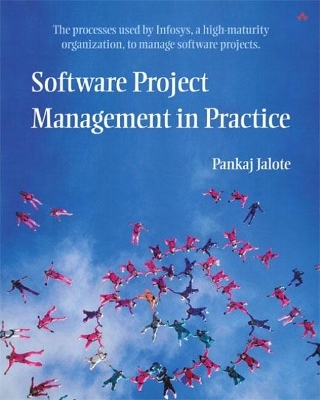
Software Project Management in Practice
Addison Wesley (Verlag)
978-0-201-73721-9 (ISBN)
Delivering high-quality software on time and on budget: it can be done. Pankaj Jalote introduces a set of practices and principles that have been used to successfully execute hundreds of projects -- of all types and sizes. Software Project Management in Practice presents the complete set of processes employed -- and proven effective -- at one of the world's most successful software organizations, Infosys Technologies. These processes, grounded in common sense and supported by simple metrics, can systematically improve the planning and execution of any software project. Since these processes satisfy the requirements of CMM Level 5 -- the industry's most challenging software process standard -- this book's examples illuminate project management as performed by a highly mature development organization. For all project managers and software professionals who may be called upon to manage projects.
Pankaj Jalote is Professor and Chairman of the Department of Computer Science and Engineering at the Indian Institute of Technology, Kanpur. He was formerly Assistant Professor in the Department of Computer Science at the University of Maryland and Vice President of Quality at Infosys Technologies, Ltd., in Bangalore, India. While at Infosys, he was one of the main architects behind Infosys’ move to high-maturity levels of the CMM. He is also the author of CMM in Practice: Processes for Executing Software Projects at Infosys (Addison-Wesley, 2000), in which he discusses the implementation of CMM in an organization. 0201737213AB07022002
Preface.
1. Managing Software Projects.
Processes and Project Management.
Project Management and the CMM.
Overview of the CMM.
KPAs for Project Management.
Project Management at Infosys.
Background: Infosys.
SEPG Support to Projects.
Senior Management Involvement in Projects.
Training for Project Managers.
The Project Management Process.
Overview of the ACIC Case Study.
Summary.
References.
I. PROJECT PLANNING.
2. The Project Planning Infrastructure.
The Process Database.
Contents of the PDB.
A Sample Entry.
The Process Capability Baseline.
Process Assets and the Body of Knowledge System.
Summary.
References.
3. Process Planning.
The Infosys Development Process.
The Standard Process.
Process Tailoring.
Example: Tailoring for Short-Duration Projects.
Requirement Change Management.
The Change Management Process.
Examples.
Process Planning for the ACIC Project.
Summary.
References.
4. Effort Estimation and Scheduling.
Estimation and Scheduling Concepts.
Effort Estimation Models.
Estimating Schedule.
Effort Estimation.
The Bottom-up Estimation Approach.
The Top-Down Estimation Approach.
The Use Case Points Approach.
Effectiveness of the Overall Approach.
Effort Estimate of the ACIC Project.
Scheduling.
Overall Scheduling.
The Effectiveness of the Approach.
Detailed Scheduling.
The Schedule of the ACIC Project.
Summary.
References.
5. Quality Planning.
Quality Concepts.
Procedural Approach to Quality Management.
Quantitative Approaches to Quality Management.
Quantitative Quality Management Planning.
Setting the Quality Goal.
Estimating Defects for Other Stages.
Quality Process Planning.
Defect Prevention Planning.
The Quality Plan of the ACIC Project.
Summary.
References.
6. Risk Management.
Concepts of Risks and Risk Management.
Risk Assessment.
Risk Identification.
Risk Prioritization.
Risk Control.
Risk Management Planning.
Risk Monitoring and Tracking.
Examples.
The ACIC Project.
The XYZ Project.
Summary.
References.
7. Measurement and Tracking Planning.
Concepts in Measurement.
Metrics and Measurements.
Process Monitoring through Statistical Process Control.
Measurements.
Collecting Effort Data.
Logging and Tracking Defects.
Measuring Schedule.
Measuring Size.
Project Tracking.
The ACIC Measurement and Tracking Plan.
Summary.
References.
8. The Project Management Plan.
Team Management.
Team Structure.
Communication.
Team Development.
Customer Communication and Issue Resolution.
The Structure of the Project Management Plan.
The ACIC Project Plan.
Summary.
9. Configuration Management.
Concepts in Configuration Management.
The Configuration Management Process.
Planning and Setting Up Configuration Management.
Perform Configuration Control.
Status Monitoring and Audits.
The ACIC Configuration Management Plan.
Summary.
References.
II. PROJECT EXECUTION AND CLOSURE.
10. Reviews.
The Review Process.
Planning.
Overview and Preparation.
Group Review Meeting.
Rework and Follow-up.
One-Person Review.
Guidelines for Reviews in Projects.
Data Collection.
Self-Preparation Log.
Group Review Meeting Log.
Group Review Summary Report.
Monitoring and Control.
The Review Capability Baseline.
Analysis and Control Guidelines.
An Example.
Introduction of Reviews and the NAH Syndrome.
The Infosys Experiment.
Data from the Experiment.
Summary.
References.
11. Project Monitoring and Control.
Project Tracking.
Activities Tracking.
Defect Tracking.
Issues Tracking.
Status Reports.
Milestone Analysis.
Actual Versus Estimated Analysis of Effort and Schedule.
Monitoring Quality.
Risk-Related Monitoring.
Milestone Analysis for the ACIC Project.
Activity-Level Analysis Using SPC.
Defect Analysis and Prevention.
Performing Pareto Analysis.
Performing Causal Analysis.
Developing and Implementing Solutions.
DP in the ACIC Project.
Process Monitoring and Audit.
Conducting the Audit.
Follow-up Actions.
Summary.
References.
12. Project Closure.
Project Closure Analysis.
The Role of Closure Analysis.
Performing Closure Analysis.
Closure Analysis Report.
The ACIC Closure Analysis Report.
Summary.
References.
Index. 0201737213T01182002
| Erscheint lt. Verlag | 11.2.2002 |
|---|---|
| Verlagsort | Harlow |
| Sprache | englisch |
| Maße | 187 x 235 mm |
| Gewicht | 440 g |
| Themenwelt | Mathematik / Informatik ► Informatik ► Software Entwicklung |
| Informatik ► Weitere Themen ► Hardware | |
| Wirtschaft ► Betriebswirtschaft / Management ► Projektmanagement | |
| ISBN-10 | 0-201-73721-3 / 0201737213 |
| ISBN-13 | 978-0-201-73721-9 / 9780201737219 |
| Zustand | Neuware |
| Haben Sie eine Frage zum Produkt? |
aus dem Bereich


